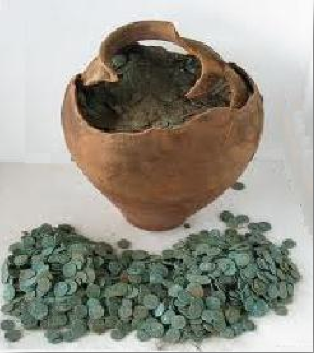Stocks & Equities
The gold doomsayers have found their champion in the media’s favorite financial advisor and one of the world’s richest men. Warren Buffett, the man dubbed the “Oracle of Omaha,” has repeatedly and publicly denied that gold is an investment, and called gold buyers “speculators” and people “who fear almost all other assets.” In fact, Buffett claims that gold’s rise has the same characteristics as the housing and dot-com bubbles, and it is only a matter of time before it reverses course. He doesn’t mean that the price will decline because of austerity measures and a free-market interest rate, mind you. He just asserts that because he’s deemed it a bubble, it will inevitably burst.
The financial world by-and-large views Buffett as an objective observer, a rare investor who still considers the best interests of common man when he speaks. Each year, there is much hullabaloo over the letter Buffett writes to the shareholders of Berkshire Hathaway. When Buffett makes a claim, the financial world coos and repeats it without question.
I concede that Buffett is a talented investor and a great communicator. He clearly has had great success and has much to offer. But that shouldn’t blind anyone to the fact that Buffett is not a trusted observer. He’s a crony capitalist who bends the truth to serve his long-held ideological commitment to big government.
In the early stages of the financial crisis, when I was writing and promoting my first book Crash Proof to warn private investors about trouble ahead, Buffett was accumulating shares in companies such as Goldman Sachs, Wells Fargo, Bank of America, and General Electric. I knew these companies were insolvent, so I wouldn’t touch them with gardening gloves on. When the credit markets seized up, Buffett worked behind the scenes and in public to make sure each of his pet companies were bailed out. This was not by coincidence. Buffett actually stated in September 2008 that he would not have invested in Goldman Sachs if not for the implicit guarantee of federal assistance. As a result, he profited at the expense of taxpayers at the very time when they were losing their savings in the markets. Meanwhile, many “in the know” politicians bought Berkshire stock during the height of the crisis, making a profit from their votes, and giving them incentive to revere Buffett all the more. Buffett once said that if the government didn’t bailout failed companies, he would be “having my Thanksgiving dinner at McDonald’s instead of having a big dinner at my daughter’s.” Seems like there were two bloated turkeys at that meal.
If Buffett were a true capitalist, he would be in favor of gold. He has noted that the value of the dollar has fallen 86% since he took over Berkshire Hathaway in 1965 and even said in his latest shareholder letter that investors are “right to be fearful of paper money.” But he continues to harp on gold. It seems the only unit of account Mr. Buffett approves are shares of his own company!
The adoption of an independent measure of value like gold presents two problems to Buffett. First, it would reduce the nominal returns of his dollar-based investing strategy. Second, it would restrict Washington’s ability to goose the financial system in his favor.
In the 19th century, when gold and silver were legal tender, the outsized returns to which Buffett has become accustomed were much harder to earn. Most people kept their money in physical bullion or bank deposits – and earned a real rate of return. Now, under the fiat system, working folks are forced into the more complicated world of equity investing. This, too, can generate real returns, but it’s a tougher playing field for the inexperienced.
Also, the fiat system artificially balloons the financial services portion of the economy. In the 19th century, fortunes were made more often by business owners than simple equity investors. People were more likely to be rewarded for providing a productive service than having direct access to the Fed’s discount window.
A quick look at Berkshire’s performance verses gold since the Credit Crunch goes a long way to explaining Buffett’s antipathy toward the yellow metal:

But Mr. Buffett’s lack of credibility goes deeper than a differing monetary philosophy. He has been in the press since last August claiming that he pays less taxes than his secretary – and urging Congress to pass a “Buffett Rule” mandating a 30% minimum tax on millionaires. The natural reaction is to say, “If you want to pay more, go ahead.” But Buffett has gone on record saying that it’s not enough for him to lead by example, and demanding that all of America’s well-off bear the burden of Washington’s reckless spending binge.
The problem is that Buffett’s entire argument is constructed on deception. Buffett is rated as the third richest man in the world for managing the nearly $393 billion in assets, and he highlights that he only pays 17.4% of his income in taxes. But this is because he earns less than 1% of his annual wealth from his salary, while over 99% is earned as the largest shareholder of Berkshire Hathaway. Buffett claims that he discounts his Berkshire holdings because he plans to give it all to charity when he dies. So, it’s not that the tax rates are so low, it’s that Buffett plans to give away 99% of his wealth.
But even accounting for this clever accounting trick, Buffett is still grossly understating his personal tax burden. He owns roughly 1/3 of Berkshire’s outstanding shares, the profits from which are subject to a 29% corporate tax rate. Last year, Berkshire paid $5.6 billion in taxes – and the IRS says they owe $1 billion more! In addition to corporate taxes, Buffett is also subject to an additional 15% capital gains tax on his stock when he cashes out, not to mention any future estate tax, leaving many to conclude that his share of taxes is certainly higher than his secretary’s.
You might wonder what Buffett would hope to gain by understating his own tax rate. To answer that, you have to understand Buffett’s ideological background. His father, Howard Buffett, was a US Congressman known for his staunch libertarianism. As has been recounted by biographers, Buffett resented being uprooted from his Omaha, NE home to move to Washington, DC and felt estranged from his stoic father. That is to say, Buffett’s commitment to the nanny state runs very deep.
But also, as mentioned earlier, Buffett personally benefits from the current corrupt state of affairs. He gets prestige from nominal gains in his stock price. He gets bailout money to guarantee the insolvent companies in which he invests. Even that estate tax that will hit him when he passes currently allows him to buy out other businesses at a steep discount.
It also shouldn’t be a surprise that humble Howard was a staunch advocate of gold and silver as money – nor that wealthy Warren rejects precious metals as having “no utility.”
The media has built Warren up to be a demigod, a straight-talking Nebraska boy that can hold his own against the vipers of Wall Street. But he is just a man with a talent for making money, and his motives should not be beyond reproach. Is he advocating the use of taxpayers’ money to bailout his business interests so he can profit? Is he being honest about what money is? Does he even understand the business cycle?
Gold prices will only go down when governments change course and make significant cuts. Until then, gold is not in a bubble. It’s the only way to protect your wealth; and in the current economic condition, it’s poised to go much higher. I think it’s high time Buffett takes to heart his father’s wise words: “For if human liberty is to survive in America, we must win the battle to restore honest money.”
Peter Schiff
C.E.O. of Euro Pacific Precious Metals
email: info@europacmetals.com
website: www.europacmetals.com
Peter Schiff is CEO of Euro Pacific Precious Metals, a gold and silver dealer selling reputable, well-known bullion coins and bars at competitive prices. To learn more, please visit www.europacmetals.com or call (888) GOLD-160.
For the latest gold market news and analysis, sign up for Peter Schiff’s Gold Report, a monthly newsletter featuring original contributions from Peter Schiff, Casey Research, and other leading experts in the gold market. Click here to learn more.

Martin Armstrong is offering you an opportunity to buy ancient Roman Coins:


The response to the offering of Roman Coins was simply overwhelming. So many people have written asking how they can buy Roman Coins and others realizing these are from the 3rd Century have asked are there examples available documenting the collapse of the monetary system? I have contacted some old friends with respect to making available a selection of Roman coins of this 3rd Century period for those interested in owning a piece of real live history and/or demonstrating the Monetary Crisis that led to the fall of Rome from a hoard of Roman coins.

Because of the turmoil of the 3rd Century and precisely the dangers we face today as government goes after citizens hunting down their wealth to confiscate to sustain their existence, what happens is they cause capital to hoard reducing the VELOCITY of money. Hoards of Roman coins of earlier chaotic periods exist, although much fewer in number. Consequently, the earlier coins tend to be much rarer. As shown above, here are two gold coins from the Post-Caesarian Civil War period (44-42BC) that followed the assassination of Julius Caesar. In the case of Brutus, a non-portrait silver denarius would bring generally $2,000-$5,000 where a silver EID MAR (bragging he killed Caesar) would be $25,000-$100,000. There are only two gold EID MAR (Ides of March) coins and these today would bring more than $1 million. The gold Ahenobarbus (supporter of Brutus) would bring well over $50,000 today.
Hoards of the 3rd Century are far more common. Pots with up to 50,000 coins have been discovered, but of course the condition is often well corroded making such coins worth perhaps $10 simply because they are a relic of the past and a piece of history. Silver and gold coins endure through the ages much better than bronze. Thus, condition of coins during the 3rd century does help to reduce the supply of decent well preserved coins in proportion to the bulk that are found over time.
Consequently, those asking the question: Is it possible to obtain coins showing the drastic collapse in silver content of the 3rd Century? This collapse took place during the reign following Valerian I (253- 260AD) who was captured by the Parthians (Persians) and stuffed as a wild animal trophy upon his death. His son, Gallienus (253-268AD) made no effort to rescue his father and the economic collapse thereafter is easily seen in the coinage. So the answer is yes! I have made arrangements for those seeking such an example of the Monetary Crisis of the 3rd Century.
This is an accommodation – not a business


The quality of these coins is virtually Extremely Fine without corrosion. All names are legible. These are the selected quality from the hoard and and are not the typical low grade junk often sold. This provides a good sampling of this period (minus the extreme rarities) that have survived thanks to the tremendous economic upheavals of the times that led people to burry their wealth.
Set of 15 one average coin of the above non-corroded, Very Fine condition all readable $595 (suitable for non-collectors)
Set of 16 above with (2) Gallienus (Silver/Bronze) Extremely Fine Top Grade all readable $2450.00 (with silvering largely intact where noted)
Prices include shipping. Payment is acceptable at: ArmstrongEconomics@HotMail.COM” data-mce-href=”mailto:ArmstrongEconomics@HotMail.COM“>ArmstrongEconomics@HotMail.COM
Or checks may be send to:
Armstrong Economics
Two Penn Center – 1500 JFK Blvd, Suite 200 – Philadelphia, Pa 19102


Photo of Goldman Sachs’ Detroit Commodity Warehouse:
Most people do not realize but there is a Commodity Empire that is run by New York’s biggest
banks/Investment Banks that are in a continued struggle with the Federal Reserve over the right to
retain the power of their commodity trading empires. They control the storage warehouses, storage
tanks, and silos constituting hard assets worth multi-billions of dollars. But it also gives them inside
information regarding inventories and the ability to manipulate the prices by moving inventory back and
forth to unreported warehouses or to London.
At the center of this power struggle has been the issue of their proprietary trading under the new
derivatives regulations. Ever since the 2008 financial crisis, the fight by Goldman Sachs, JPMorgan Chase,
and Morgan Stanley to retain or expand their valued physical commodity operations has been roaring
silently behind the headlines of mainstream media.
This is coming to a head and the Fed will most likely yield allowing banks more freedom to invest in the
physical commodity world even far more than they did prior to 2008. True, the Fed could order them to
sell off the assets that they use to boost their inside trading ability. However, it is unlikely that the Fed
will really enforce the ban on such trading. Goldman has been arguing that they have a right to remain
in that business for it is what you call being ‘grandfathered’ in prior to 2008 and are thus part of their
“merchant banking” investments, promising to keep them segregated from the trading desks – fat
chance!
The whole problem with the New York Banks is that they are greedy. They are just not satisfied being
banks. They began merging with commodity firms in the 1980s. They began speculating and then to
reduce risk, they formed the “club” and began infiltrating government to change the direction of
regulation. When they lose, they are always bailed out and when they win, they keep the profits.
Regulators and lawmakers have allowed them to do as they like. As long as the government needs to
borrow money every year, they are scared to death to really regulate the banks at all beyond pomp and
show. In theory, the banks are under pressure to reduce risk on their balance sheet and that would
seem to suggest that they should get out of the commodity business. Morgan Stanley is the only one of
the three that has any foundation to be in the business. They are an Investment Bank with real live
brokerage operations. Goldman does brokerage for institutional clients, but that is primarily so they
have also access to inside information. They are not a national retain firm and in the crisis, they applied
to become a bank to be able to borrow from the Fed.
While the Fed’s does not want to appear to be accommodating, most politicians will not say anything
until the shit-hits-the-fan again. Hell, most are hoping Goldman will hire them. The notion that the
sentiment in Washington is somehow about reducing risk, let’s face the truth, most on Capitol Hill are
clueless about what is risk. So while the drama circulates around pretending the banks may lose their
commodity power, it is unlikely to ever happen. It is just more pomp and circumstance without substance.
Martin Armstrong is offering you an opportunity to buy ancient Roman Coins:


The response to the offering of Roman Coins was simply overwhelming. So many people have written asking how they can buy Roman Coins and others realizing these are from the 3rd Century have asked are there examples available documenting the collapse of the monetary system? I have contacted some old friends with respect to making available a selection of Roman coins of this 3rd Century period for those interested in owning a piece of real live history and/or demonstrating the Monetary Crisis that led to the fall of Rome from a hoard of Roman coins.

Because of the turmoil of the 3rd Century and precisely the dangers we face today as government goes after citizens hunting down their wealth to confiscate to sustain their existence, what happens is they cause capital to hoard reducing the VELOCITY of money. Hoards of Roman coins of earlier chaotic periods exist, although much fewer in number. Consequently, the earlier coins tend to be much rarer. As shown above, here are two gold coins from the Post-Caesarian Civil War period (44-42BC) that followed the assassination of Julius Caesar. In the case of Brutus, a non-portrait silver denarius would bring generally $2,000-$5,000 where a silver EID MAR (bragging he killed Caesar) would be $25,000-$100,000. There are only two gold EID MAR (Ides of March) coins and these today would bring more than $1 million. The gold Ahenobarbus (supporter of Brutus) would bring well over $50,000 today.
Hoards of the 3rd Century are far more common. Pots with up to 50,000 coins have been discovered, but of course the condition is often well corroded making such coins worth perhaps $10 simply because they are a relic of the past and a piece of history. Silver and gold coins endure through the ages much better than bronze. Thus, condition of coins during the 3rd century does help to reduce the supply of decent well preserved coins in proportion to the bulk that are found over time.
Consequently, those asking the question: Is it possible to obtain coins showing the drastic collapse in silver content of the 3rd Century? This collapse took place during the reign following Valerian I (253- 260AD) who was captured by the Parthians (Persians) and stuffed as a wild animal trophy upon his death. His son, Gallienus (253-268AD) made no effort to rescue his father and the economic collapse thereafter is easily seen in the coinage. So the answer is yes! I have made arrangements for those seeking such an example of the Monetary Crisis of the 3rd Century.
This is an accommodation – not a business


The quality of these coins is virtually Extremely Fine without corrosion. All names are legible. These are the selected quality from the hoard and and are not the typical low grade junk often sold. This provides a good sampling of this period (minus the extreme rarities) that have survived thanks to the tremendous economic upheavals of the times that led people to burry their wealth.
Set of 15 one average coin of the above non-corroded, Very Fine condition all readable $595 (suitable for non-collectors)
Set of 16 above with (2) Gallienus (Silver/Bronze) Extremely Fine Top Grade all readable $2450.00 (with silvering largely intact where noted)
Prices include shipping. Payment is acceptable at: ArmstrongEconomics@HotMail.COM
Or checks may be send to:
Armstrong Economics
Two Penn Center – 1500 JFK Blvd, Suite 200 – Philadelphia, Pa 19102

“Thousands upon thousands are yearly brought into a state of real poverty by their great anxiety not to be thought of as poor.” – Robert Mallett

I hear the term de-leveraging relentlessly from the mainstream media. The storyline that the American consumer has been denying themselves and paying down debt is completely 100% false. The proliferation of this Big Lie has been spread by Wall Street and their mouthpieces in the corporate media. The purpose is to convince the ignorant masses they have deprived themselves long enough and deserve to start spending again. The propaganda being spouted by those who depend on Americans to go further into debt is relentless. The “fantastic” automaker recovery is being driven by 0% financing for seven years peddled to subprime (aka deadbeats) borrowers for mammoth SUVs and pickup trucks that get 15 mpg as gas prices surge past $4.00 a gallon. What could possibly go wrong in that scenario? Furniture merchants are offering no interest, no payment deals for four years on their product lines. Of course, the interest rate from your friends at GE Capital reverts retroactively to 29.99% at the end of four years after the average dolt forgot to save enough to pay off the balance. I’m again receiving two to three credit card offers per day in the mail. According to the Wall Street vampire squids that continue to suck the life blood from what’s left of the American economy, this is a return to normalcy.
The definition of normal is: “The usual, average, or typical state or condition”. The fallacy is calling what we’ve had for the last three decades of illusion – Normal. Nothing could be further from the truth. We’ve experienced abnormal psychotic behavior by the citizens of this country, aided and abetted by Wall Street and their sugar daddies at the Federal Reserve. You would have to be mad to believe the debt financed spending frenzy of the last few decades was not abnormal.

The Age of Illusion
“Illusions commend themselves to us because they save us pain and allow us to enjoy pleasure instead. We must therefore accept it without complaint when they sometimes collide with a bit of reality against which they are dashed to pieces.” – Sigmund Freud
In my last article Extend & Pretend Coming to an End, I addressed the commercial real estate debacle coming down the pike. I briefly touched upon the idiocy of retailers who have based their business and expansion plans upon the unsustainable dynamic of an ever expanding level of consumer debt doled out by Wall Street banks. One only has to examine the facts to understand the fallacy of a return to normalcy. We haven’t come close to experiencing normalcy. When retail sales, consumer spending and consumer debt return to a sustainable level of normalcy, the carcasses of thousands of retailers will litter the highways and malls of America. It will be a sight to see. The chart below details the two decade surge in retail sales, with the first ever decline in 2008. Retail sales grew from $2 trillion in 1992 to $4.5 trillion in 2007. The Wall Street created crisis in 2008/2009 resulted in a decline to $4.1 trillion in 2009, but the resilient and still delusional American consumer, with the support of their credit card drug pushers on Wall Street, set a new record in 2011 of $4.7 trillion.

…..read more HERE


Below are factors that suggest that water will be the world’s most sought-after commodity in a handful of decades.
I couldn’t help but notice a new ad on Yahoo! Mail from Fidelity Investments that boldly asks, “Are you ready for water to become a globally traded commodity?”
This video accompanying the Fidelity Investments ad is as thought-provoking as it is ominous. The video discusses the respective costs in water to make items like a slice of bread, a cup of coffee, and a hamburger. From the video: “With global population expected to increase by 30 percent by 2050 and more developing nations transitioning to higher standards of living, regional water shortages and peak water issues will become more widespread.” The issue of water becomes more complicated in considering the accessibility and availability of drinking water in the years to come. From the video: “Global consumption of water is expected to increase by 40 percent over the next 20 years. And according to some estimates, more than half of the world’s population could be living under conditions of water stress by 2025.” Thus, the video suggests that water stress could intensify geopolitical affairs and “border disputes” related to the water supply.
…..read more and view Action Items (scroll to the bottom) HERE












